Fitness
Planet Fitness Business Model – How Planet Fitness Makes Money?
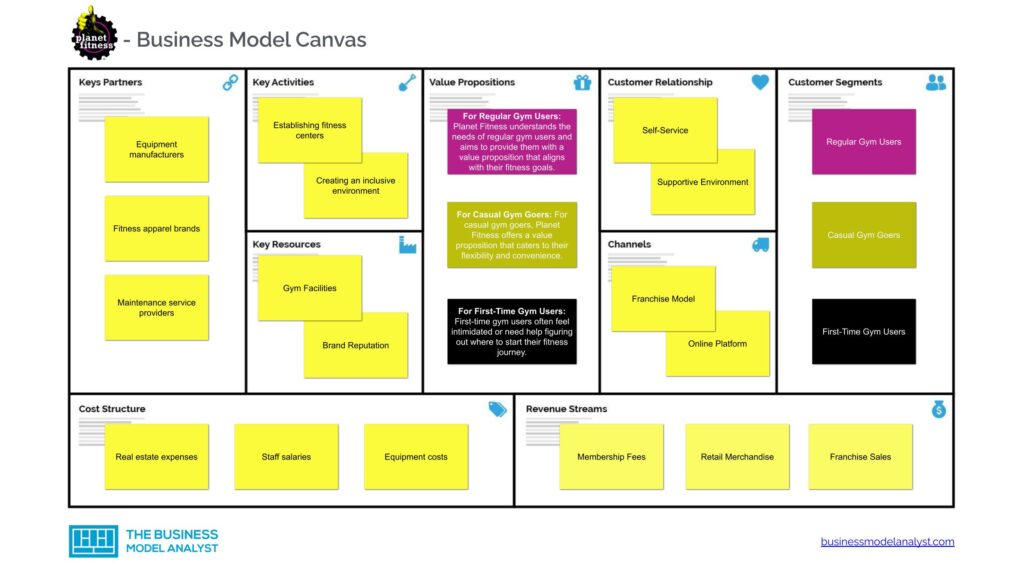
The Planet Fitness business model revolves around providing affordable and accessible fitness options to customers across the United States. Founded in 1992, Planet Fitness aims to make fitness accessible to everyone, regardless of their fitness level or financial situation. Their innovative approach has created a welcoming and non-intimidating environment for their members.
With over 2,000 locations nationwide, Planet Fitness offers a variety of amenities, including state-of-the-art equipment, free fitness training, and a judgment-free zone. Their membership plans are competitively priced, making fitness affordable for people of all backgrounds.
This article will examine the details of Planet Fitness’s business model, its approach to customer acquisition, revenue generation, and unique value proposition. We will also analyze its strengths, weaknesses, and factors contributing to its success in the fitness industry.
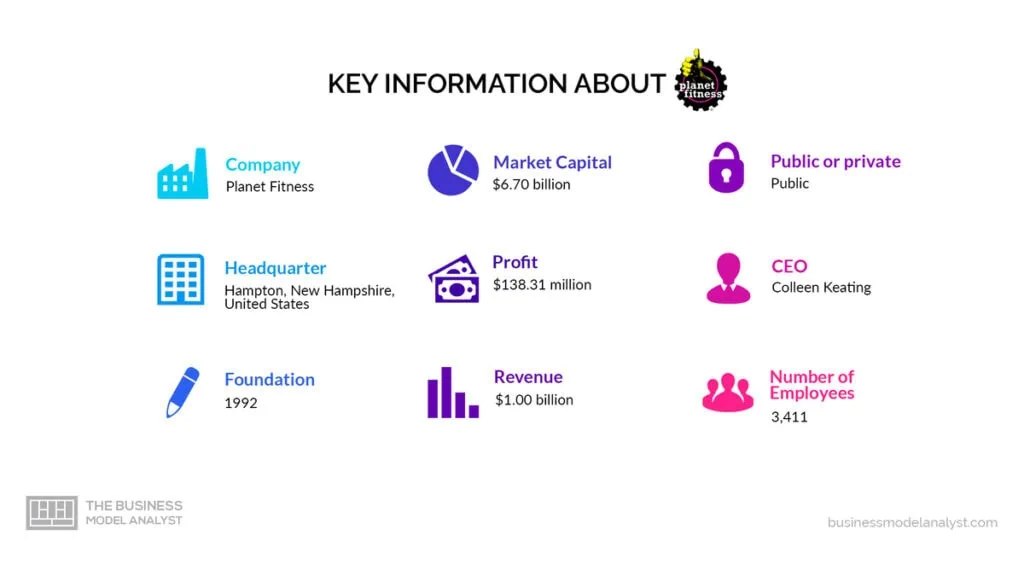
A brief history of Planet Fitness
The story of Planet Fitness begins in 1992 in Dover, New Hampshire. At the time, the fitness industry was dominated by high-end gyms targeting fitness enthusiasts and bodybuilders. But brothers Michael and Marc Grondahl saw an opportunity to create a gym that would be more welcoming and accessible to everyday people who just wanted to get in shape.
The Grondahl brothers opened their first gym, which they named “Planet Fitness,” to create a non-intimidating and judgment-free environment where anyone, regardless of their fitness level, could feel comfortable working out. They wanted to eliminate the barriers that often deterred people from going to the gym, such as the overwhelming presence of experienced weightlifters and the pressure to have the perfect gym body.
The Grondahls focused on creating a friendly and welcoming atmosphere at Planet Fitness to achieve their goals. They emphasized a no-judgment policy, ensuring people could work out at their own pace without feeling self-conscious. They also offered various cardio and strength equipment to accommodate different fitness preferences and goals.
The gym attracted a loyal following as word spread about Planet Fitness and its unique approach. Members appreciated the affordable membership prices and the inclusive environment, which made them feel comfortable and motivated to continue their fitness journey.
In 2003, after 11 years of operation, the company marked a significant milestone by establishing its initial franchised location. This allowed the gym to rapidly expand its presence and reach more communities across the United States. Franchise owners embraced the concept of Planet Fitness, and within a few years, the gym had multiplied its locations across the nation.
One key factor contributing to Planet Fitness’s success was its unique business model. Unlike traditional gyms, which relied heavily on long-term contracts and high monthly fees, Planet Fitness revolutionized the fitness industry by introducing a low-cost membership model. This approach appealed to a broader demographic, including budget-conscious individuals and those who hesitated to commit to a traditional gym.
Planet Fitness also introduced the concept of the “Judgment Free Zone,” which became a core component of its brand identity. This slogan resonated with individuals who felt intimidated or judged in other gym environments. The company’s commitment to creating a judgment-free space has been the cornerstone of its success, attracting millions of members nationwide.
Today, Planet Fitness continues to expand its footprint, with over 2,400 locations across the United States and internationally. The gym remains committed to its founding principles of affordability, inclusivity, and a non-intimidating atmosphere. It continues to innovate and adapt to the changing fitness landscape, offering a variety of classes, training programs, and amenities to meet the evolving needs of its members.
Planet Fitness has undoubtedly left an indelible mark on the fitness industry, challenging the status quo and redefining what it means to be a gym. With its customer-centric approach and dedication to providing an accessible and friendly environment, Planet Fitness has helped countless individuals embark on their fitness journeys confidently and positively.
Who Owns Planet Fitness
Institutional investors and mutual funds primarily own Planet Fitness. As of August 12th, 2024, the largest shareholder is BlackRock Advisors LLC, which holds 11,049,989 Class A shares, representing 12.62% ownership. BlackRock Advisors LLC is a global investment management corporation managing over $813 million in Planet Fitness shares.
Vanguard Fiduciary Trust Co. is the second-largest institutional shareholder, with 8,174,617 Class A shares, representing 9.339% ownership. It is a subsidiary of Vanguard Group, one of the largest investment management companies globally.
SRS Investment Management LLC also holds a significant stake in Planet Fitness, with 6,111,508 Class A shares, representing 6.982% ownership. The New York-based investment firm manages around $450 million worth of Planet Fitness shares.
Cadian Capital Management LP follows with 5,664,237 Class A shares, representing 6.471% ownership. This private investment firm has approximately $417 million invested in Planet Fitness.
Amundi Asset Management U.S., Inc. is the final major institutional investor, with 4,565,312 Class A shares, representing 5.216% ownership. Amundi Asset Management U.S., Inc. is a subsidiary of Amundi, a leading European asset management company, and they manage around $336 million worth of Planet Fitness shares.
In addition to institutional ownership, several key individual shareholders own Planet Fitness. Christopher Rondeau owns 459,638 shares, representing 6.867% ownership, and Richard L. Moore holds 243,711 shares, representing 3.641% ownership.
Marc Grondahl owns 125,000 shares, representing 1.867% ownership. Stephen Spinelli holds 124,052 shares, representing 1.853% ownership. Craig Benson owns 123,252 shares, representing 1.841% ownership.
These individual shareholders play essential roles within the company and are interested in its success. Christopher Rondeau, for example, has a long history with Planet Fitness and has served as its CEO. The current CEO is Colleen Keating, who was appointed in June 2024.
Planet Fitness Mission Statement


Planet Fitness’ mission statement is “to enhance people’s lives by providing a high-quality fitness experience in a welcoming, non-intimidating environment, which we call the Judgement Free Zone, where anyone — and we mean anyone — can feel they belong.”
How Planet Fitness works
Planet Fitness operates on a unique business model focused on providing a variety of fitness amenities and services at an affordable price. The company aims to make fitness accessible to all individuals, regardless of age, skill level, or fitness background.
To become a Planet Fitness member, individuals can sign up either online or in person at one of their locations. Membership options are available for individuals, couples, and families, with different pricing tiers depending on the level of access and services desired.
Once members, they gain access to a range of fitness equipment and amenities, including cardio machines, strength training equipment, free weights, and more. Planet Fitness clubs also offer amenities such as tanning beds, hydro massage beds, and massage chairs, providing members with additional relaxation and self-care options.
Planet Fitness prides itself on its supportive and inclusive environment, where everyone is welcome and encouraged to pursue their fitness goals at their own pace. The famed “Judgment Free Zone” philosophy is a centerpiece of the company’s culture.
In addition to the physical fitness facilities, Planet Fitness offers various member benefits and value-added services. These can include access to fitness training programs, group exercise classes, workshops on nutrition and healthy living, and online resources to track progress and set goals.
As part of its commitment to affordability, Planet Fitness keeps its membership fees low while offering flexible membership options. Members can choose between a month-to-month membership or an annual commitment, allowing individuals to find a plan that best suits their needs and budget.
Planet Fitness operates on a pay-as-you-go system, meaning members are billed monthly with no long-term contracts or cancellation fees. This flexible approach gives individuals control over their membership and fitness journey.
How Planet Fitness makes money
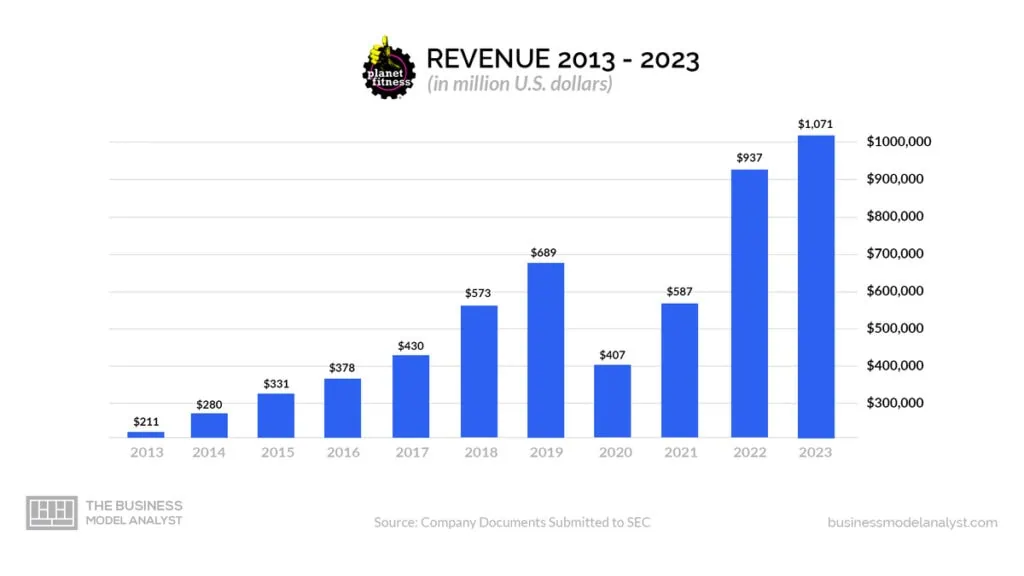

Planet Fitness operates a membership-based business model. The company offers gym facilities and services to individuals who pay monthly or annual membership fees. Although Planet Fitness provides a low-cost membership option, the company relies on a large membership base to generate revenue. The following are the ways through which Planet Fitness makes money:
Membership Fees
Planet Fitness’s primary source of revenue is the membership fees paid by its members. Members can access the gym facilities, including workout equipment, group exercise classes, and locker rooms. Planet Fitness offers different membership options, including monthly and annual memberships. The membership fees vary depending on the location and the type of membership chosen. The low-cost membership fees make fitness accessible to many individuals, attracting a large customer base.
Retail Merchandise
Planet Fitness sells retail merchandise, including fitness apparel, accessories, and nutritional supplements, at its gym facilities. Members and non-members can purchase these merchandise items, providing an additional source of revenue for the company. The retail merchandise helps promote the Planet Fitness brand and enhances the overall customer experience.
Franchise Fees
Planet Fitness operates under a franchise model, allowing entrepreneurs to open and operate their own gym locations. Franchisees pay franchise fees and ongoing royalties to Planet Fitness in exchange for using the brand, operational systems, and marketing support. These franchise fees and royalties contribute to Planet Fitness’s overall revenue.
Planet Fitness Business Model Canvas
The Planet Fitness Business Model can be explained in the following business model canvas:
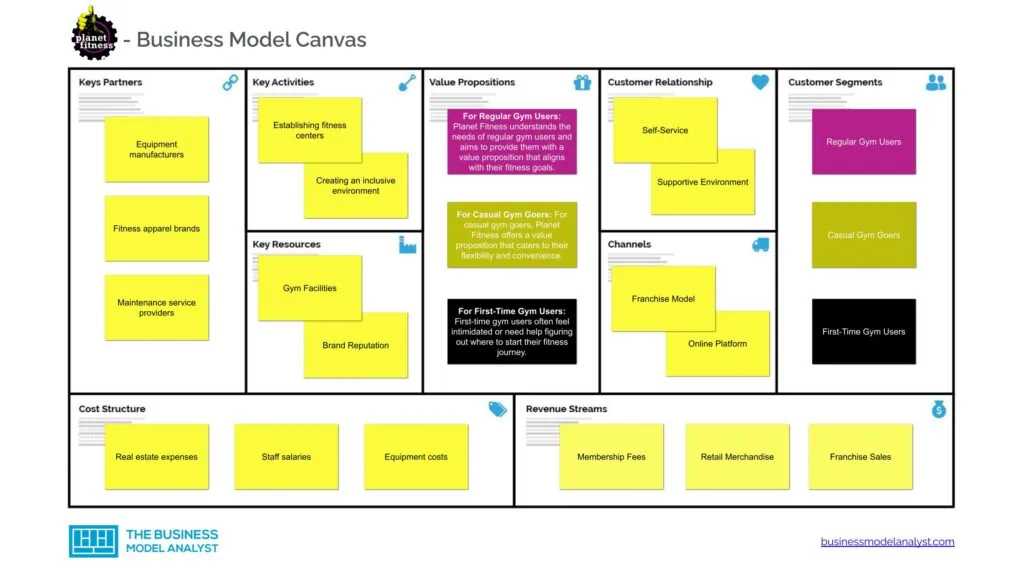

Planet Fitness Customer Segments
Planet Fitness has a diverse customer segment, catering to individuals seeking an affordable and non-intimidating fitness experience. The customer segments of Planet Fitness include:
- Regular Gym Users: These individuals comprise a significant portion of Planet Fitness’s customer segment. They are interested in maintaining a healthy lifestyle and staying fit. They may have different fitness goals, such as losing weight, building muscle, or improving cardiovascular health. Planet Fitness aims to provide a welcoming and non-judgmental environment for these individuals to achieve their fitness goals;
- Casual Gym Goers: Planet Fitness also appeals to casual gym goers who may not have a strict fitness routine but still want to maintain some physical activity. These customers may visit the gym occasionally and are not necessarily focused on specific fitness goals. They appreciate the convenience and accessibility of Planet Fitness locations and enjoy the option to work out on their terms;
- First-Time Gym Users: Planet Fitness targets first-time gym users who may feel intimidated by traditional fitness centers. The company aims to break down barriers to entry by providing a comfortable and judgment-free environment where newcomers can feel at ease while learning the ropes of using gym equipment and starting their fitness journey;
- Budget-Conscious Individuals: A significant portion of Planet Fitness’ customer segment comprises budget-conscious individuals who prioritize affordability regarding their fitness memberships. Planet Fitness offers low-cost membership options to attract these customers and make fitness accessible to a broader population;
- Beginners and Novices: Planet Fitness caters to individuals who are new to fitness or have limited experience in the gym. The company provides a supportive and beginner-friendly atmosphere, offering introductory fitness classes, personal training options, and guidance on using equipment properly. This segment appreciates the educational resources and assistance provided by Planet Fitness in helping them reach their fitness goals;
- Community-Oriented Individuals: Planet Fitness attracts customers who value community within their fitness journey. The company fosters a friendly and inclusive atmosphere where members can connect with like-minded individuals who share their commitment to fitness and well-being. This community-driven approach creates a unique selling point for Planet Fitness.
Planet Fitness Value Propositions
Planet Fitness value propositions consist of:
- For Regular Gym Users: Planet Fitness understands the needs of regular gym users and aims to provide them with a value proposition that aligns with their fitness goals. They emphasize a welcoming and non-intimidating environment where individuals can work towards maintaining a healthy lifestyle.
Planet Fitness offers a wide range of cardio and strength training equipment and amenities such as locker rooms, showers, and tanning beds. Their value proposition for regular gym users centers on affordability, convenience, and a supportive atmosphere that encourages customers to reach their fitness goals.
- For Casual Gym Goers: For casual gym goers, Planet Fitness offers a value proposition that caters to their flexibility and convenience. They understand these individuals may have a relaxed fitness routine but want to stay active.
Planet Fitness provides accessible locations and extended operating hours, allowing casual gym goers to fit exercise into their busy schedules. Their low-cost membership options also make it appealing for those looking for a budget-friendly fitness solution.
- For First-Time Gym Users: First-time gym users often feel intimidated or need help figuring out where to start their fitness journey. Planet Fitness acknowledges this and offers a value proposition that addresses their concerns.
Planet Fitness strives to create a nonjudgmental and supportive atmosphere that welcomes newcomers. It provides beginner-friendly equipment, introductory fitness classes, and personal training options, allowing first-time gym users to feel comfortable and gain confidence in their fitness abilities.
- For Budget-Conscious Individuals: Planet Fitness understands that cost is an essential factor for many individuals when choosing a gym membership. Their value proposition for budget-conscious individuals is centered around affordability.
Planet Fitness offers low-cost membership options that provide access to its facilities and amenities at a fraction of the cost of traditional fitness centers. By removing financial barriers, Planet Fitness aims to make fitness accessible to a broader population.
- For Beginners and Novices: Planet Fitness recognizes that beginners and novices may require additional guidance and support as they start their fitness journey. Their value proposition for this segment includes educational resources such as workout plans, instructional videos, and fitness tips.
Planet Fitness also offers personal training options for those who prefer more personalized guidance. It empowers beginners and novices by providing the necessary tools and resources to build their fitness foundation.
- For Community-Oriented Individuals: Planet Fitness understands the importance of a supportive community in achieving fitness goals. Their value proposition for community-oriented individuals revolves around fostering a sense of belonging and camaraderie.
Planet Fitness encourages social interaction through member appreciation events, group fitness classes, and online communities. They create an environment where customers can connect with like-minded individuals, share experiences, and motivate each other on their fitness journeys.
Planet Fitness Channels
Planet Fitness channels consist of:
- Franchise Model: Planet Fitness operates primarily through a franchise model, allowing individuals and businesses to own and manage their own Planet Fitness locations;
- Online Platform: Planet Fitness offers its members online services and resources, including a member portal, fitness tracking tools, virtual classes, and an online community;
- Mobile App: Planet Fitness has a mobile app gives users access to their membership information, workout schedules, exercise tutorials, and exclusive member discounts;
- Marketing Channels: Planet Fitness utilizes various marketing channels, such as social media, television advertisements, digital advertising, and partnerships with influencers, to reach potential customers and promote its brand.
Planet Fitness Customer Relationships
Planet Fitness customer relationships consist of:
- Self-Service: Planet Fitness focuses on providing a self-service experience to its customers. Members can access the gym and use its facilities without extensive staff interaction;
- Supportive Environment: Planet Fitness aims to create a non-intimidating and supportive environment for all members, regardless of their fitness level or experience. This helps foster positive relationships between the company and its customers;
- Community Engagement: Planet Fitness encourages community engagement through its initiatives, such as the Judgement Free Generation program and partnerships with charitable organizations to promote a healthy lifestyle and give back.
Planet Fitness Revenue Streams
Planet Fitness revenue streams consist of:
- Membership Fees
- Retail Merchandise
- Franchise Sales
Planet Fitness Key Resources
Planet Fitness key resources consist of:
- Gym Facilities: Planet Fitness relies on well-equipped gym facilities with various exercise machines, weights, cardio equipment, and amenities like tanning beds and massage chairs;
- Brand Reputation: Planet Fitness has built a strong brand reputation. It is known for its affordable and inclusive gym experience and for attracting and retaining customers;
- Technology Infrastructure: Planet Fitness invests in technology systems and platforms to enable member interactions, online services, fitness tracking, and data analysis;
- Partnerships: Planet Fitness leverages strategic partnerships with fitness equipment manufacturers, suppliers, and sponsors to enhance its offerings and generate revenue.
Planet Fitness Key Activities
Planet Fitness key activities consist of:
- Establishing fitness centers
- Creating an inclusive environment
- Ensuring facility cleanliness
- Providing diverse workout equipment
- Offering group fitness classes
- Employing knowledgeable staff
- Promoting health and wellness
- Adapting fitness programs
Planet Fitness Key Partners
Planet Fitness key partners consist of:
- Equipment manufacturers
- Fitness apparel brands
- Maintenance service providers
- Certified personal trainers
- Marketing agencies
- Health influencers
- Insurance providers
- Technology partners
- Software providers
Planet Fitness Cost Structure
Planet Fitness cost structure consists of:
- Real estate expenses
- Staff salaries
- Equipment costs
- Marketing expenses
- Rental and utility fees
- Insurance premiums
- Technology expenses
- Employee training costs
- Administrative expenses
- Research and development expenditures
Planet Fitness Competitors
Planet Fitness operates in a highly competitive industry. Here are several of its key competitors:
- Anytime Fitness: Anytime Fitness is one of Planet Fitness’s most direct competitors. It also focuses on providing affordable gym access with a 24/7 operating model;
- Gold’s Gym: With a strong brand presence and a wide range of amenities and services, Gold’s Gym competes with Planet Fitness by offering a more premium fitness experience;
- 24-Hour Fitness: As the name suggests, 24-Hour Fitness differentiates itself by offering round-the-clock access. It targets individuals who seek flexibility in their workout schedules;
- LA Fitness: LA Fitness is known for its extensive facilities, offering a wide range of exercise equipment, group fitness classes, and premium amenities. It often attracts customers seeking more extensive fitness options;
- Crunch Fitness: Crunch Fitness provides a more vibrant and energetic workout experience. It offers diverse classes, specialized training programs, and unique amenities such as colorful lighting and music;
- Snap Fitness: Snap Fitness is another affordable gym chain that provides smaller, neighborhood-focused facilities for convenience and ease of access;
- Equinox: Targeting a more upscale market, Equinox is known for its luxury amenities, high-end facilities, personalized services, and premium fitness offerings;
- YMCA: While not a direct competitor, the YMCA offers fitness facilities, classes, and programs at various locations, often positioning itself as a community-centered and family-friendly option.
Despite competing with these established brands, Planet Fitness has successfully carved out a niche by targeting the casual and first-time gym-goer demographic. Its business model focuses on making fitness accessible, non-intimidating, and affordable, differentiating it from many competitors.
Planet Fitness SWOT Analysis
The SWOT analysis provides an in-depth evaluation of a company’s internal strengths and weaknesses and external opportunities and threats. In the case of Planet Fitness, it is essential to examine the factors that contribute to its success and those that may pose challenges in the ever-evolving fitness industry.
By understanding Planet Fitness’ strengths, weaknesses, opportunities, and threats, we can gain more insights into its business model and potential for future growth.
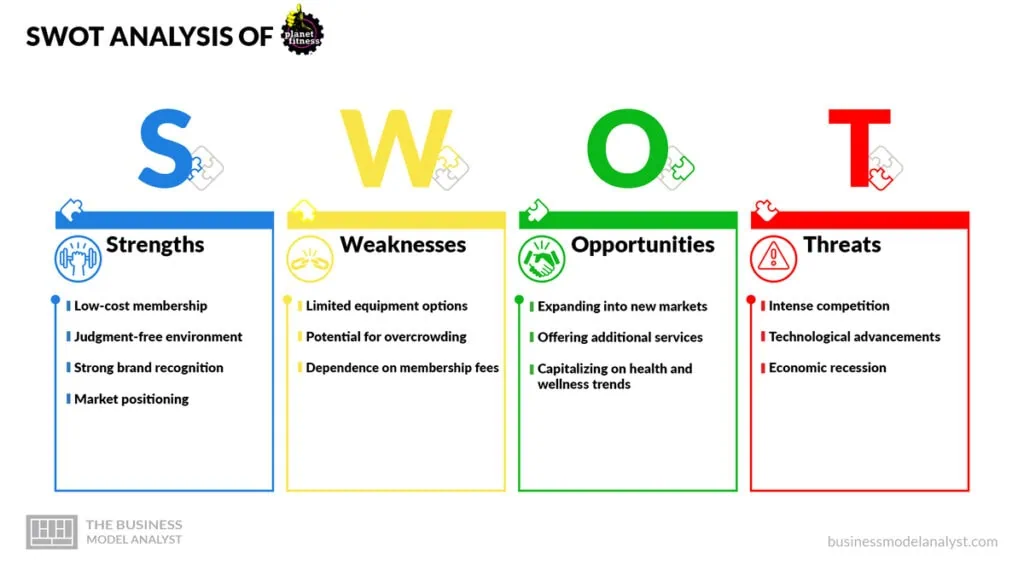

Planet Fitness Strengths
- Low-cost membership: Planet Fitness offers affordable membership plans compared to other gym chains, making it attractive to cost-conscious customers;
- Judgment-free environment: The company has successfully created a non-intimidating and inclusive atmosphere, encouraging individuals of all fitness levels to join and exercise without feeling self-conscious;
- Strong brand recognition: Planet Fitness has established itself as a well-known brand in the fitness industry, with a positive reputation for its inclusive approach and no-frills facilities;
- Market positioning: Their business model targets most people who want an affordable and straightforward gym experience, allowing them to capture a broad customer base.
Planet Fitness Weaknesses
- Limited equipment options: The gym primarily focuses on essential exercise equipment and does not offer cutting-edge or specialized fitness machines, which may deter fitness enthusiasts from seeking more advanced workout options;
- Potential for overcrowding: Since low-cost membership plans attract many customers, specific Planet Fitness locations may become crowded, leading to longer wait times for equipment and reduced customer satisfaction;
- Dependence on membership fees: The company generates most of its revenue from membership fees, making it vulnerable to economic downturns or the loss of members during economic recessions.
Planet Fitness Opportunities
- Expanding into new markets: As the demand for affordable fitness options continues to grow, Planet Fitness can expand its presence into new geographical locations domestically and internationally;
- Offering additional services: Re-introducing services like personal training or new ones like specialty fitness programs can attract a broader range of customers and increase revenue streams;
- Capitalizing on health and wellness trends: With increasing health consciousness and the growing popularity of fitness, Planet Fitness can leverage this trend to attract new members and maintain its market share.
Planet Fitness Threats
- Intense competition: The fitness industry is highly competitive, with many established gym chains and local fitness centers offering a range of services and price points, threatening Planet Fitness’ market share;
- Technological advancements: As technology continues to play a significant role in the fitness industry (e.g., virtual workouts and fitness apps), Planet Fitness must adapt and offer innovative digital solutions to remain competitive;
- Economic recession: During an economic downturn, individuals may cut back on discretionary spending, including gym memberships, potentially affecting Planet Fitness’ revenue and growth. Additionally, an economic recession may lead to a reduction in overall consumer spending on fitness services.
Conclusion
Planet Fitness’s business model has proven to be highly successful and unique within the fitness industry. By targeting the underserved market of casual gym-goers, the company has consistently attracted a large customer base and achieved significant financial growth.
Their low-cost membership pricing, judgment-free zone environment, and emphasis on creating a supportive and inclusive community have set them apart from traditional gyms and allowed them to thrive in a highly competitive market. With its strong brand positioning and customer loyalty, Planet Fitness will likely continue to lead the fitness industry for years to come.









